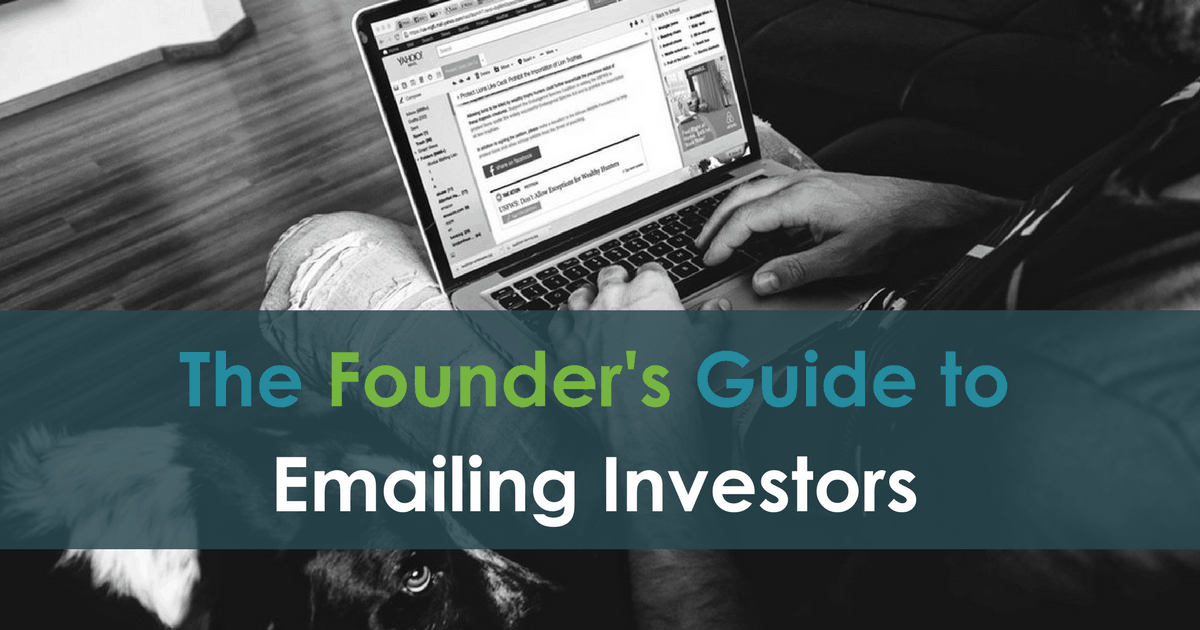By Tian DuBelko
Ever heard of the saying, “It’s not what you know, it’s who you know”? For tech founders and entrepreneurs, building and sustaining connections with investors is key to business success. Whether you’re emailing cold leads or contacting intrigued investors, you must be able to communicate your thoughts and ideas effectively. That’s why in this post, we’ll show you everything that you need to know about writing an email to investors.
When Should You Email Investors?
For tech startup founders, there are two main reasons for emailing investors:
- Pitching: When you need funding, the best way to begin your pitch is through email. If you can, have a colleague or someone in your investor network refer you. If that’s not an option, but you believe the investor and your startup would be a great fit, introduce yourself and your startup through a cold email.
- Updating: So you’ve made your pitch, locked down funding, and built rapport with an investor. But you still need to keep your them updated on what your startup is up to. If you can, give a monthly update that informs your investor of any major news, significant changes, and your progress towards milestones and goals. To streamline the process, create a standardized email that you can always refer back to and include personalized content. More on this later.
Recommended: 8 Keys to Pitching Investors for Funding
How Should You Email Investors?
Before you go off emailing investors, you need to know how to write an email that accomplishes what you want. Follow these steps to craft a winning email.
Research Before You Write
While you might have to sometimes send a cold email, it’s best to never send an email that is truly cold. Make sure you do your research and understand the investor you’re pitching to. If you can show investors that you’ve done your homework and know more than just the funding basics, your cold email will be better received.
Tip: Try pitching junior partners of the fund. Junior partners generally receive fewer pitches and may be more receptive to new venture ideas, and in turn, your cold email.
Craft a Precise Subject Line
The first email you send an investor might be the only chance you have at getting their attention and impressing. And the first thing they see is the subject line. You don’t want to write a subpar email subject line that gets marked as spam or overlooked.
For your first-time emails, lead with a clear subject line. That means including your startup name and a brief description if space permits. Use only as many words as you need to make clear the purpose for your email. Most email clients will cut off your subject line if it gets too long.
Even if you’re seeking later funding rounds, it helps to be clear in your subject line. Investors tend to be busy people, and if they can’t tell immediately from the subject line what it is you want, they’ll quickly move on to the next email.
Begin With a Lean Introduction
As with the subject line, we want to keep it simple and concise. A single sentence introducing yourself and your role within the startup will suffice. You’ll have more opportunities to offer a more detailed introduction later.
Recommended: How Tech Entrepreneurs Should Talk to Investors
Show How Your Startup Solves a Problem
Now is the time to showcase your startup. However, instead of giving a detailed company history or other superfluous information, describe what your company does in basic terms. Too many buzzwords and jargon will only confuse investors, especially if they’re not well versed in tech lingo.
Your goal here is to highlight the primary problem your company is working to fix. It’s fine to include a brief description of your product or service that you’re developing, but do try to keep your description to three or four sentences at most. Yes, the specs of your product/service are fascinating to you, but at this point, investors only want a basic snapshot of your startup and what it does.
Recommended: How to Attract VC Investors as a Tech Startup
Explain What Value Your Startup Provides
So, your potential investor has a mental snapshot of what your startup does and the steps you plan to take to do it, now what? Now you need to explain in very clear terms how your startup adds value and how you (and your investor) will make money. One way to present this information is through bullet points, which cuts through all the fluff.
You’ll want to include details such as your company size, your potential market growth, your current traction, and how much you’ve already fundraised. These are all important factors an investor takes into consideration and including all this information up front shows that you’re serious about getting funded.
Tip: If you’ve already secured notable founders’ support, be sure to include this detail.
Highlight Your Startup’s Achievements
Feel free to include some concise details here about why your startup deserves the investment or why your industry is primed for growth. If you attended a prestigious university, or have prior success with startups, here’s your opportunity to highlight your achievements and savviness.
Investors feel more comfortable working with founders with outstanding credentials since those founders are expected to lead a dynamic team and cultivate a strong workplace culture.
Recommended: How Tech Founders Can Cultivate A Strong Workplace Culture
Link to Your Pitch Deck
Whether you’re cold emailing or writing with a warm referral, be sure to always include a pitch deck directly in your email or a link to it. It’ll help interested investors make an easier decision.
You want to provide investors with all the information they need to make a decision, and you don’t want them to waste time emailing you for more information on your startup. Make it easy for them and include it in your first email.
Include a Call to Action
A well-crafted email to an investor should always include a call to action at the end. Rather than ask for a large investment right away, try to arrange a future interaction to build rapport.
No matter what you’re asking of your investor, whether it’s a quick call or a brief Skype session, provide a clear and specific time frame. Make it clear what you would like to discuss and provide a clear time length, i.e. 15 minutes, so that there is no confusion about the nature of the call.
Recommended: The Tech Founder’s Guide to Raising a Seed Round
How NOT to Email Investors
Mislead With False Info/Data
Look, investors are shrewd entrepreneurs who are experienced with funding startups. In fact, they’ve probably led a few startups themselves. With how many pitches they receive, investors are well-practiced in spotting fake information and deceptive data from miles away. Never, ever try to mislead investors, no matter if you’re sending the first or the tenth email. It’s simply in bad faith and you’ll be exposed and blacklisted sooner than later.
Start With Long Introductions
Some investors get up to hundreds of emails a day, and they don’t have time to read through lengthy emails. Writing a long chunk of text will likely deter investors from reading the rest of your email. They simply don’t have the time to decipher a block of text, so don’t send them one. Keep your email simple and straightforward for better results.
Send Them Inappropriate Pitches
Doing research will help you find investors who would be a great fit for your company and prevent you from sending your pitch to investors that aren’t focused on your industry. Even in the broad tech industry, you’ll want to have specific investors or firms in mind when writing your pitch email. Otherwise, you’re simply wasting your time.
Recommended: How Founders Can Fund Their Tech Startups
How To Send Investors Updates
Don’t think your work is done, even at the seed stage. Your investors are vital to your long-term growth, so try your best to maintain a good relationship. The easiest way to do this is to crush your objectives, but another way to do this to keep your investors in on the loop through monthly updates.
Having a standardized email will make it easy for investors to keep track from month to month. List your monthly priorities, give a quick financial update, outline your key performance indicators (KPIs), and summarize any product updates. As with your other emails, try to keep it to the point.
In order to maintain a good relationship with investors, it’s important to send them consistent updates, even if the news is bad. To get investors to trust you, show that you have nothing to hide. And sometimes, investors will have some words of wisdom for a predicament you may find yourself in.
Ready to Jump In?
Choosing the right shared tech office space can jumpstart your tech business and accelerate your company’s growth. In the right ecosystem, you’ll have an easier time hiring top talent, expanding your network, and even securing the next round of funding.
Think your Seattle tech company might be a good fit for extraSlice’s community of trendsetters and innovators? Then book a tour of our tech campus or visit our website to learn more about The Place for Tech!
Want to take this resource with you? Download it here.






